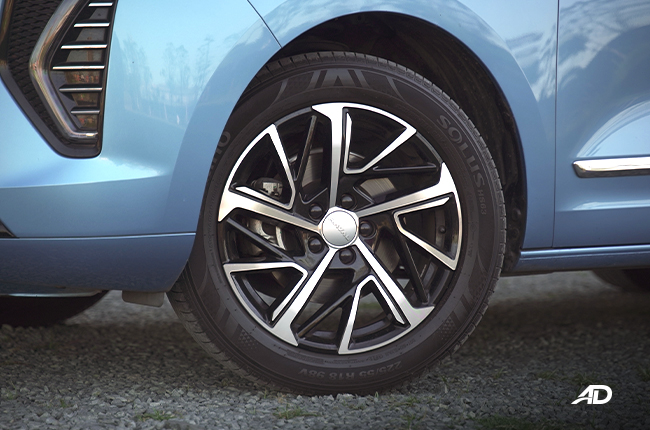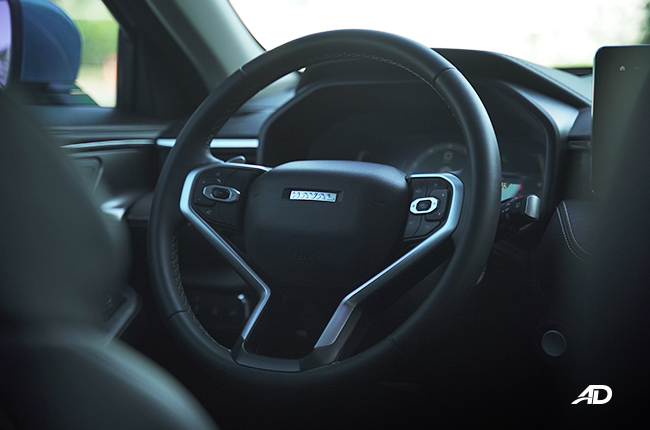
Last year, we were able to experience the top-of-the-line variant of GWM’s Haval Jolion crossover, the Haval Jolion HEV DHT Supreme. We were thoroughly impressed with the hybrid version’s driving performance and, though we have reservations about its refinement, were also impressed with the amount of tech and safety features inside it as well.
With the Haval Jolion HEV, we believe that it can hold its own against more established names in the segment despite its hefty price tag. This time around, we’re taking a look at its non-hybrid variant, the Haval Jolion DCT Supreme. Priced at P1,248,000, the Haval Jolion DCT Supreme is P340,000 less than its hybrid brother which begs the question, is it P340,000 worth of savings, or is it P340,000 less car?
Engine Output (HP), Acceleration, Transmission, Handling 4.0/5
Exterior & Interior Design, Quality, Fit and Finish, Ergonomics 3.5/5
Cabin Comfort, Suspension, NVH Insulation 4.0/5
Convenience Technologies, Active and Passive Safety Features 4.0/5
Amount of the vehicle you get for the price, Fuel Efficiency 4.0/5
- Smooth shifting seven-speed DCT
- Screens and cameras provide a clear and crisp view
- Ride is planted yet sufficiently supple
- Infotainment is hard to navigate
- Lacks physical buttons to operate most of its features
Exterior
Starting with the looks, the Haval Jolion DCT Supreme pretty much looks the same as the hybrid version albeit without the hybrid badging and some key differences. To distinguish the non-hybrid variant from its hybrid brother, the Haval Jolion DCT Supreme sports a different style of 18-inch two-tone wheels that are reminiscent of a pinwheel’s vanes. Another difference is at the back where non-hybrid Haval Jolion comes with a simpler rear spoiler.
All in all, in the design department at least, you’re not missing out on much except for some blue badging and a different set of wheels.
Interior and comfort

Inside, you’ll be greeted by seats wrapped in black leather, metallic accents on the doors, and matte plastics. Unlike the hybrid version which has two-tone leather seats paired with copper/bronze accents, the non-hybrid version is simpler overall.
Because so little is different, our complaints about the hybrid version still ring true with the non-hybrid Haval Jolion which is the lack of physical buttons for the AC controls and other features on the car. It isn’t a deal breaker by any means because the Haval Jolion is packed full of features, but, if you’re not fond of controlling everything on the infotainment system, this will cause a bit of annoyance.

As for cargo space, this is where the non-hybrid version of theHaval Jolion wins over its hybrid brother slightly. Unlike the hybrid Haval Jolion which has 390 liters of space, the non-hybrid DCT Supreme has 430 liters, 40 liters more space thanks to the absence of battery packs.
However, because the DCT Supreme is lighter compared to the HEV, there is a slight difference in the ride characteristics. Both cars still feel comfortable and plush when you drive them on Metro Manila’s roads, but the HEV has a bit more dampening compared to the non-hybrid version.

Everywhere else, the Haval Jolion DCT Supreme is much the same as the HEV. The chassis still remains composed over uneven surfaces, and the model demonstrates impressive resilience to deeper road imperfections. Noise, vibration, and harshness (NVH) levels are still top-notch with minimal wind intrusion into the cabin.
Technology
Moving to the tech features, the Haval Jolion DCT Supreme retains most of the toys on the HEV variant. It has the same 12.3-inch touchscreen display with a crisp and clear resolution along with a full six-speaker setup.
Good news right? Considering its P340,000 less than its hybrid version, having the same entertainment features is a great deal. But, with the same features come the same flaws so expect to do some deep and lengthy digging in the infotainment system to access the car’s features like what we had to do with the Haval Jolion DHT Supreme.
Safety
On the topic of safety, it’s also the same story as the non-hybrid Haval Jolion comes equipped with a comprehensive array of safety features. Standard features include ABS, six airbags, ISOFIX tethers, brake assist, electronic stability control, hill-start assist, roll-movement intervention, secondary collision mitigation, traction control, tire pressure monitoring, automatic crash unlock function, automatic locking return function, automatic fuel cut-off function, and intelligent door anti-error locking function.

Furthermore, the DCT Supreme also sports an ADAS system. This system comprises adaptive cruise control, automatic emergency braking, blind spot warning, cross traffic alert and brake, forward collision warning, intelligent cornering control, lane center keeping assist, lane change assist, lane departure warning, lane keeping assist, rear collision warning, traffic jam assist, and emergency lane keeping assist. The only thing missing from the non-hybrid variant is the Intelligent Cornering Control feature.
Performance

Under the hood of the Haval Jolion DCT Supreme is a 1.5-liter turbocharged four-cylinder gasoline engine that pumps out 141 hp and 220 Nm of torque. This mill is paired with a seven-speed Wet Dual Clutch Transmission that unlike most DCTs available on the market, actually shifts smoothly without any noticeable lag. The engine revs smoothly and picks up speed quite well from a stop, but, because it has a lower output, the performance kind of falls flat when you reach the 90 km/h mark.

On the move, if you compare it to the hybrid Haval Jolion you will feel a power deficit when you move down to the non-hybrid DCT Supreme. On the other hand, like the hybrid, the non-hybrid has crisp cornering and handling characteristics and a refined comfortable ride. However, as we mentioned before, due to the non-hybrid variant being lighter, the ride has a slightly faster rebound when tackling bumps.

Overall, the Haval Jolion DCT Supreme is still a competent crossover providing a good balance of performance, comfort, and refinement albeit with slightly less power than its hybrid sibling. On its own though, if you don’t compare it to its hybrid version and compare it to other turbocharged gasoline crossovers, the Haval Jolion DCT Supreme can put up a good fight against other established names.
Fuel Economy
In our previous review of the Haval Jolion HEV, we managed to get 12.8 km/L in hellish city traffic, on the highway, we got it up to 18 km/L and higher with less traffic.
In comparison, the Haval Jolion DCT Supreme managed to get nine to 10 km/L in the city and 14 to 15 km/L on the highway. Taking into account that it doesn’t have the assistance of electric motors and the fact that it is turbocharged, two to three kilometers less efficiency is not so bad overall.
Verdict and Price

As we said in the beginning, the Haval Jolion DCT Supreme, priced at P1,248,000 is P340,000 less expensive than the Haval Jolion HEV DHT Supreme which has a sticker price of P1,588,000.
With the Haval Jolion DCT Supreme, you get almost all of the same features as the hybrid variant, you also get the same ride, comfort, and driving characteristics. Though you sacrifice extra power, fuel efficiency, and coding-free motoring by going internal combustion only, the non-hybrid Haval Jolion is still a great car overall.
To answer the question we put forward earlier on whether going non-hybrid means less amount of car or more savings, our answer would have to be most definitely savings.
If you want to take a look at GWM’s local offerings here in the Philippines, check out the GWM Car Guide on AutoDeal.com.ph. Take a look, maybe your next car is among them.
Image Gallery
Specifications
Engine
1.5 LFuel Type
GasolinePerformance
141 hp @ 5,600 rpmTransmission
Automatic-
Summary
-
Name GWM Haval Jolion DCT Supreme Body Type Crossover Price ₱1,248,000 Transmission Category Automatic -
Engine
-
Engine Size 1.5 L Displacement 1,498 cc Number of Cylinders 4 Number of Valves 16 Transmission Type 7-Speed Wet Dual Clutch Transmission -
Performance
-
Drivetrain Front-Wheel Drive Max Output (hp) 141 hp @ 5,600 rpm Max Torque (nm) 220 Nm @ 2,000 rpm -
Economy & Environment
-
Fuel Type Gasoline Emissions Standard Euro 5 Fuel Capacity 55.0 L *Combined Fuel Consumption 12.50 km/L *brand manufacturer claim
-
Dimensions
-
Length 4,472 mm Width 1,841 mm Height 1,574 mm Wheelbase 2,700 mm Turning Circle 12 m Ground Clearance 168 mm Trunk Capacity 430 L Number of Doors 5 Number of Seats 5 -
Safety & Security
-
Driver's Airbag 1 Front Passenger's Airbag 1 Side Airbag 2 Curtain Airbag Knee Airbag Auto Brake System Electronic Brake Distribution Anti-lock Brake System (ABS) w/ Electronic Brakeforce Distribution
Immobilizer Security Alarm Stability Control Electronic Door Locks Speed Sensing Door Locks ISOFIX Lane Departure Warning System Blind-Spot Detection System -
Features
-
Cruise Control Front Parking Sensors Rear Parking Sensors Leather Upholstery Push Start Button Wheel Size 18 in Wheels Metal Type Alloy Airconditioning System Dual-Zone Automatic + Rear A/C Vents Entertainment System 12.3-inch Touch Screen via 6-Speakers Connectivity Apple Carplay + Android Auto + Bluetooth + USB Navigation Ready Warranty 7 Years(200,000KM) Keyless Entry Roof Rack Sunroof Electric Adjustable Seats Power Steering Power Windows Power Outlet Steering Wheel Audio Control -
Technology
-
Active Park Assist Hill Start Assist AWD Modes n/a Tire Pressure Monitoring Heads-up Display Power Liftgate Start-stop System
Colors
Latest Review
-
2026 BYD eMAX 7 Review / Review
Can the BYD eMAX 7 prove that electric MPVs work in the Philippines? With 201 hp and 530 km of range, it just might.
4.3 / 5 -
2026 Hyundai Creta N-Line Review / Review
The Creta N-Line isn’t just a Creta with sporty looks; it’s got the performance and bite to back up its style.
4.3 / 5 -
2026 BYD Shark 6 DMO Review / Review
Can a hybrid pickup truck break the mold of what pickup trucks can be? The Shark 6 DMO has something to say about that.
4.6 / 5
Popular Articles
-
Electric Vehicles in the Philippines for under P1 million
Jerome Tresvalles · Aug 19, 2025
-
Top 3 Cars For Every Lifestyle—What Cars Are Right For You? | Behind a Desk
Caco Tirona · Apr 24, 2024
-
5 Tips to Maximize Fuel Efficiency
Jerome Tresvalles · Sep 09, 2024
-
Five driving habits that are draining your fuel tank
Jerome Tresvalles · Jun 24, 2025
-
Can engine braking harm your engine?
Jerome Tresvalles · Sep 11, 2025
-
Do electric cars even need maintenance?
Jerome Tresvalles · Oct 23, 2024
-
Best vehicles for an active outdoor lifestyle
Shaynah Miranda · Jul 25, 2024
-
How to drive different types of vehicle transmissions
May 23, 2024
-
5 easy ways to keep your car interior clean
Allysa Mae Zulueta · Nov 15, 2021
-
How to survive Metro Manila traffic
Earl Lee · Aug 16, 2022






















